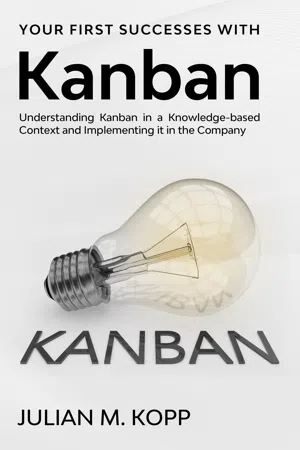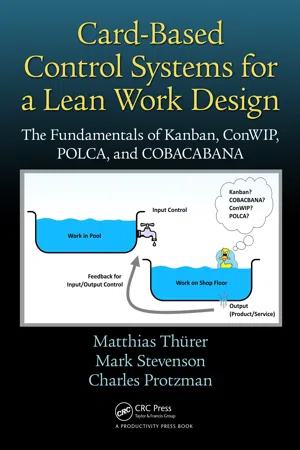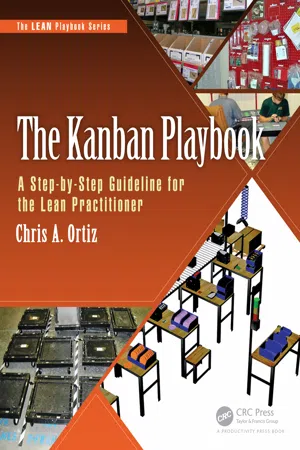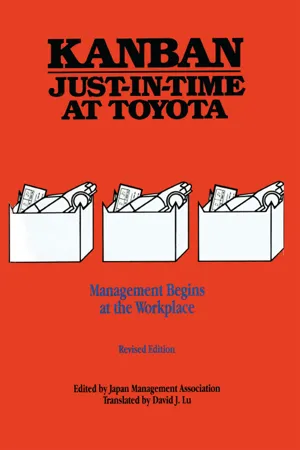Kanban Boards
Kanban boards are visual tools used to manage and track work in progress. They typically consist of columns representing different stages of a process, with cards or sticky notes representing individual tasks or items. This method helps teams visualize their workflow, identify bottlenecks, and prioritize tasks, making it a popular tool in software development and project management.
8 Key excerpts on "Kanban Boards"
- eBook - ePub
Improve
The Next Generation of Continuous Improvement for Knowledge Work
- George Ellis(Author)
- 2020(Publication Date)
- Butterworth-Heinemann(Publisher)
...Of course we don’t know with certainty. That's why knowledge work relies so heavily on experts. 21.5 Kanban Task Management Kanban is a bit like the Chinese board game Go—a few moments to learn, a lifetime to master [3]. A Kanban board is a visual way to perform Just-In-Time Rationalization with irregular tasks. It helps teams deal with uneven flow of tasks and creates transparency so internal customers can see what the team is working on. The Kanban board is based on Kanban inventory management, which was derived by Taiichi Ohno and others in Toyota from American supermarkets in the 1950s [4]. Kanban Task Management was applied to knowledge work on a large scale by David Anderson, who helped develop Agile Software Management [5]. The concept can be demonstrated with an ordinary lunch buffet at a pizza restaurant, as shown in Fig. 21.6. When a server (1) sees a type of pizza is running low, he or she (2) signals a request to the kitchen for more pepperoni pizzas. The kitchen (3) starts a new pizza and, a few minutes later, (4) delivers it to the buffet table. Fig. 21.6 A pizza buffet is a pull system with downstream flow driven by upstream signals. The key lean principle in Fig. 21.6 is to see how the upstream signals trigger the downstream flow. These signals help the restaurant respond at just the right rate when, for whatever reason, pepperoni slices are taken at half the rate one day compared to the next. They are the key to the Kanban board [6] of Fig. 21.7. This is a physical board with sticky notes (or it's virtual equivalent) that flow from left to right. Each note represents one task. The backlog of tasks is unlimited; any customer to the process can add work to the backlog, but there's no commitment on when the backlogged work will start—implying, of course, that entering a task in the backlog gives no indication of when, or even if, the task will be worked on. Fig...
- eBook - ePub
Your First Successes with Kanban
Understanding Kanban in a Knowledge-based Context and Implementing it in the Company
- Julian M. Kopp(Author)
- 2020(Publication Date)
- Books on Demand(Publisher)
...Basics of Kanban Kanban is a visual system for managing the work during a process. Kanban visualizes both the process (the workflow) and the actual work that goes through this process. The goal of Kanban is to identify and eliminate potential bottlenecks in your process so that the work can be done cost-effectively, at optimal speed or throughput. Where does Kanban come from? - A short story about Kanban The first kanban system was developed in the 1940s (after World War II) by Taiichi Ohno for Toyota Automotive in Japan. It was developed as a simple planning system whose goal was to optimally control and manage work and inventory in every phase of production. The goal was to make optimal use of the very limited resources and means available after the war years and to increase productivity and efficiency of production to the level of international (especially American) competition. With Kanban, Toyota achieved a flexible and efficient just-in-time production control system that increased productivity while reducing the cost-intensive inventory of raw materials, semi-finished and finished products. Ideally, a Kanban system controls the entire value chain from the supplier to the end user. In this way, supply interruptions and overstocking of goods in different phases of the manufacturing process are avoided. Kanban requires continuous monitoring of the process. Particular attention is paid to bottlenecks that occur, which would slow down the entire process. The goal is to achieve higher throughput with shorter delivery times. Over time, Kanban has developed into an efficient way of working in a variety of production systems. Kanban was originally conceived as an optimization approach for manufacturing companies in the production of physical products. From physical production to knowledge work While Kanban was introduced to the manufacturing industry by Taiichi Ohno, it was David J...
- eBook - ePub
Agile HR
Deliver Value in a Changing World of Work
- Natal Dank, Riina Hellström(Authors)
- 2020(Publication Date)
- Kogan Page(Publisher)
...Overall, the Kanban framework helps to facilitate self-organization and the pull -based working system. The aim is to limit work in progress to an agreed amount and allow new pieces of work to be pulled in only once other items are finished. This approach helps teams to not overcommit or lose time attempting to multitask. Often teams start with a basic Kanban board (Figure 6.1) and the columns of Backlog, To Do, Doing and Done. Then, based on the different aspects and nuances of their work, they may introduce new columns, work streams or ticketing systems. For example, an HR services team might use work streams to represent the different business units that they support, or begin to use coloured tickets to separate urgent work from BAU. These approaches could even be overlaid with new columns to separate work that has been reviewed in detail and prioritized from a bigger list that captures all the new work or requests coming in from the business. This means that the Kanban framework allows multiple products or services to be worked on at the same time as well as to cover different customer groups. For these reasons, a lot of HR teams find the Kanban framework useful; we’ll explore more examples in Chapter 10. Figure 6.1 Example Kanban board Figure 6.1 details The details of the board with three types of shaded post-it notes are as follows: Icebox: everything Backlog: agreed To do (next): smaller chunks plus planned tasks Doing WIP equals 6: blocked, 70 percent planned capacity Done. Some of the core principles that help guide the Kanban framework include: Visualize all work and understand dependencies by using either a physical or an electronic board. Limit work in progress (WIP) based on the true capacity of the team or organization, with the aim of reducing bottlenecks or clogging up of the system...
- eBook - ePub
Card-Based Control Systems for a Lean Work Design
The Fundamentals of Kanban, ConWIP, POLCA, and COBACABANA
- Matthias Thurer, Mark Stevenson, Charles Protzman(Authors)
- 2017(Publication Date)
- Productivity Press(Publisher)
...Chapter 5 The Inventory Control Problem: Kanban Systems Highlights We outline the six rules of kanban systems. We outline the difference between a work-in-process kanban system and a production kanban system. We outline the implications for the use of kanban to control the flow of independent product/service flows through a set of resources (i.e. shop floor control). We discuss the applicability of kanban systems. The previous four chapters outlined how we conceptualize a production/service system, what a card-based system is, and what all card-based systems discussed in this book have in common. We also outlined four criteria that determine different control problems. This and the following chapters will now discuss each of the card-based control solutions in the light of these criteria—each suitable for a different control problem. We will start in this chapter with kanban systems. Kanban A visual signal, kanban literally means to watch over a board for a period; it is like a sign outside a business, but with a soul (Protzman et al. 2010). It is typically a sheet of paper/plastic/metal—a physical card (see Figure 5.1 for some examples). This is why the kanban system is called a card-based system—in fact, it is the original card-based system. The card may be integrated into a container or material handling device...
- eBook - ePub
The Kanban Playbook
A Step-by-Step Guideline for the Lean Practitioner
- Chris A. Ortiz(Author)
- 2015(Publication Date)
- Productivity Press(Publisher)
...Chapter 3 Kanban Cards Introduction Kanban cards are a visual signal system that is implemented to trigger the need for inventory. These cards are placed all over the facility as needed and can have a significant impact on output and productivity. Cards can be placed in work areas and used when material and supplies are running low, with the card turned into a material handler to retrieve the needed item. The card contains all the vital information needed, including part number, part description, quantity, and locations. Kanban card systems can also be used when ordering from outside suppliers but generally take longer to implement. This chapter describes the internal Kanban card system of a company. Benefits of Kanban Reduced inventory Reduced cost Reduced floor space use Reduced motion Creates better visibility of shortages Helps transform to a pull system Controls inventory Creates a robust and repeatable system Kanban Defined Japanese word for “signal” Used to pull and trigger work Moving product through the shop Ordering material and parts Ordering supplies Requesting paperwork Calling for help or assistance Creating a Kanban Card System Break down items into categories Remove all unused parts, material, supplies Establish maximum quantity: usage is key Establish the minimum quantity Establish the reorder signal or quantity Right size the area (smarter storage size) Implement 5S for organization Make Kanban cards Implement Kanban card system Break Down Items into Categories Parts Brackets Panels Material Sheets of metal Shop supplies Rags, fillers, adhesives, cleaners, lubricants, tape Hardware Nuts/bolts/washers, fasteners, and so on Establish Maximum Quantity: Usage Is Key Get an idea...
- eBook - ePub
Applying Lean in Health and Social Care Services
Improving Quality and the Patient Experience at NHS Highland
- Cameron Stark, Gavin Hookway(Authors)
- 2019(Publication Date)
- Productivity Press(Publisher)
...This reduces the likelihood of incorrect orders, as can occur when staff manually transcribe order details. ■ The kanban includes details of where on the department it is to be stored, and so reduces the likelihood that the material is stored in a different area, with the likelihood for confusion. ■ The kanban decouples the flow of supplies from direct supervision – the system established allows supplies to flow without separate supervision of the process. (Kitazuka and Moretti 2012). The system may be used within a ward, clinic, office or care home. In that case, there will often be a designated person who checks the kanban post and restocks. The Japan Management Association (1989) refer to a similar role in an industrial setting as ‘a whirligig beetle’ that moves on water and changes direction rapidly – which gives a good impression of rapid movement. They also note that the person in this role has an important function in also conveying information. 8.10.1 Further Details: Production Kanban In industry, kanban are used to control the production schedule. Kanbans indicate to the final process what needs to be produced, and other kanban then ‘pull’ required items to the final process – for example, the suspension required for a car (Japan Management Association 1988: pp 79–99). This ensures that only items that required for the final process are produced. It also means that the only part of the process that needs to know exactly what is being made is the final process. It is therefore relatively quick to change the mix of items being produced. In health and social care, Kanbans generally have a more limited role. Hirano (2009c) identifies two main types of kanban used in production: kanbans that show when parts are to be moved (Transport kanban) and kanban used to give instructions on what procedures are to be performed (Production kanban)...
- eBook - ePub
Kanban Just-in Time at Toyota
Management Begins at the Workplace
- Japan Management Association(Author)
- 2018(Publication Date)
- Routledge(Publisher)
...If there are too many kanban, the information is no longer accurate. For example, many parts are needed for a sub-assembly process, but if there are too many kanban pieces, one does not know which part is needed at the moment. We have discussed again and again the importance of kanban, making it into a tool that controls and improves the workplace. Reducing the number of kanban has the effect of restraining as much as possible the number of start-ups within the process. In this way, existing problems can be made apparent — a useful function of the kanban. But if there are too many pieces of kanban, they can hide problems. What is the use of kanban, then, if we simply use them to be attached to or detached from parts and materials? Simply put, the fewer the number of kanban, the better. With fewer, their sensitivity is greater. Beware of the propensity to overdo the kanban. It is a route marked with failure. Use your mind wisely. There are many uses for kanban to raise the performance level of your workplace. We often say that the level of a given workplace is known by its use of kanban. So far, we have explained the basic thinking and content of the kanban system. However, as far as the kanban system is concerned, unless one has actually experimented with it, one can never truly understand its essence. “Improvement is eternal and infinite.” And at Toyota we say: “The use of kanban must not be limited to the preservation of the status quo. The task given to the people connected with the kanban system is to use their imagination and effort to let it develop further.”...
- eBook - ePub
- Productivity Press Development Team(Author)
- 2020(Publication Date)
- Productivity Press(Publisher)
...The cowboys are needed to point the herd in the right direction and to lasso and restrain them when they stray. In other words, controls are not needed when everything is normal. They are only needed to point the way for the normal flow and to identify when abnormalities occur and quick action is needed. In the kanban system visual controls are used to keep a smooth flow of production going from customer order back to supplier purchasing, to limit the abnormalities that might occur without the visual controls, and to signal when abnormalities do occur. Five Important Steps in Creating Visual Controls The following are some basic applications of visual control that you will need for your kanban system: 1. Determine the locations where parts and products are to be stored between processes and mark them clearly. Indicate the storage location on the kanban. Figure 5-4 shows how signboards and lights alert material handlers (water beetles) to what material is needed and where it is located. 2. Erect andons (display lamps and alarms) to signal when the line is stopped for defects or difficulties on the line, and as signals for replenishment of parts. 3. Place a kanban above the cell or production line to indicate what work is in process, the status of preparations, and so on. 4. Display kanbans so that cycle time, stock on hand, and work procedures can be known easily with a glance. 5. Include order-point indicators, or triangle kanbans (Figure 5-8), at the storage locations so that operators will know at a glance when to replenish. The next section discusses this step in detail. Figure 5-4. Storage Locations Figure 5-5. Andons Figure 5-6. A Scheduling Board Figure 5-7...







